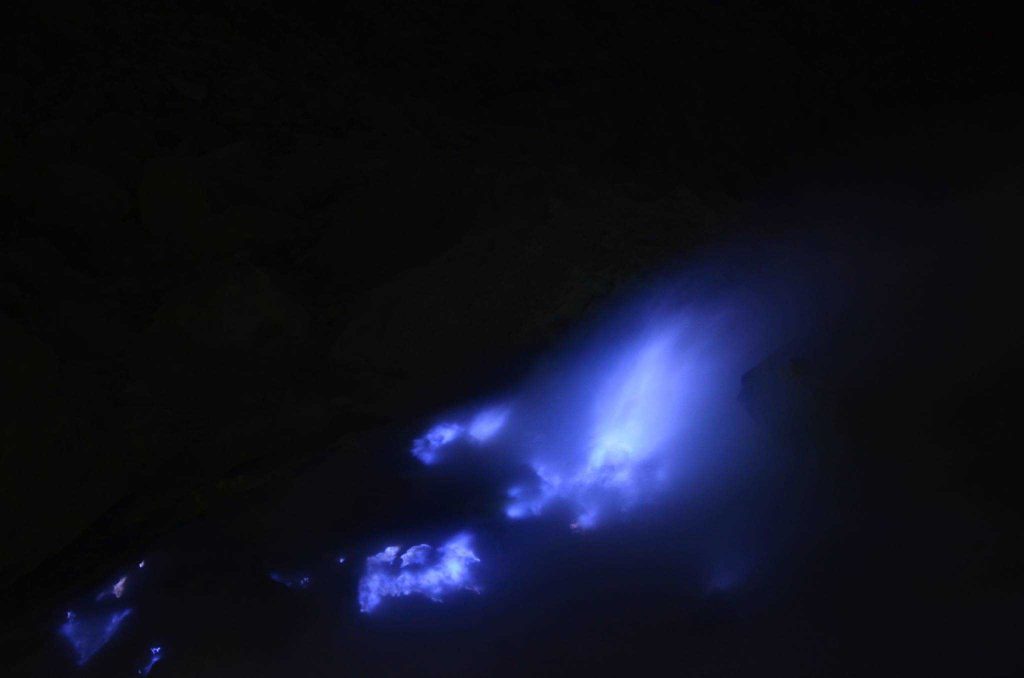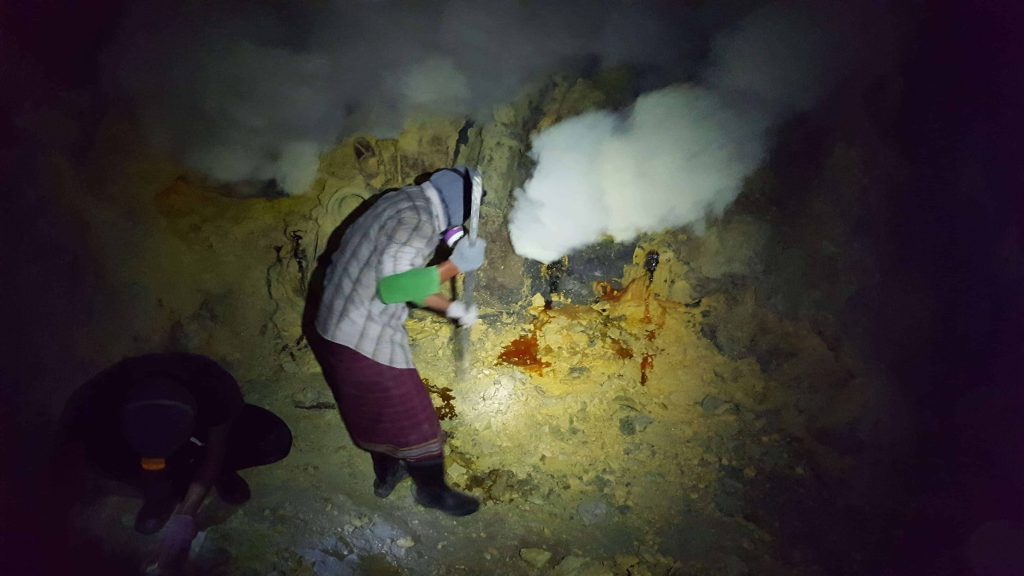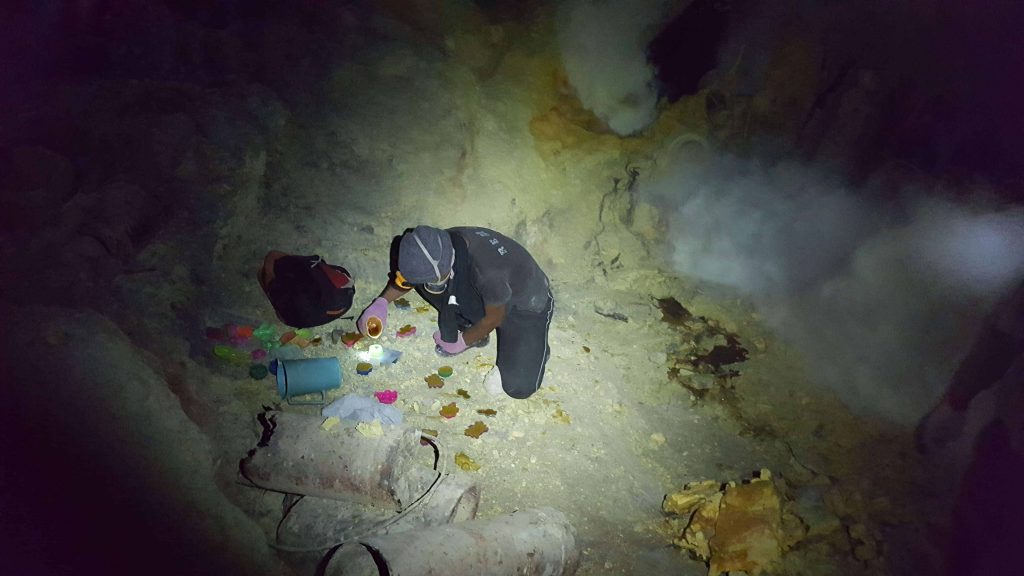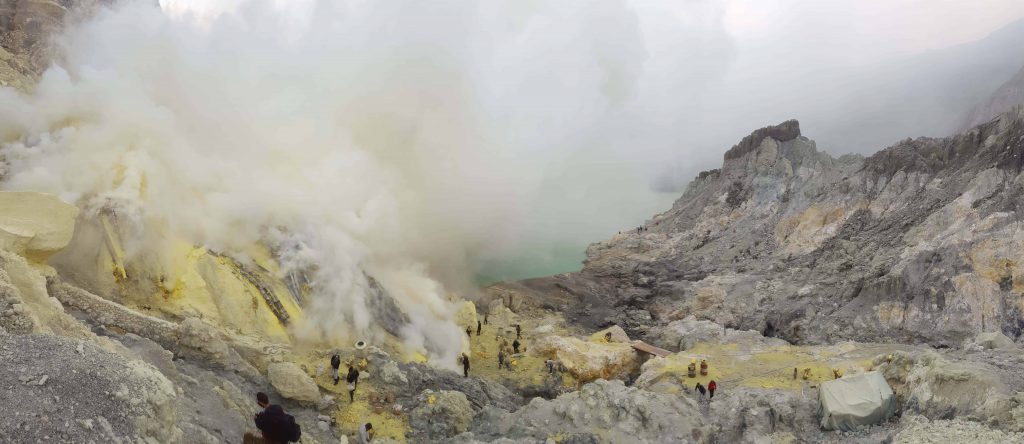When I first heard about Crater Ijen, or Kawah Ijen as Indonesians call it, I was going from the volcano Mount Bromo to Probolinggo, and then I was going to head to Banyuwangi, the nearest city to Kawah Ijen. Before going to Banyuwangi, I only knew that there was a volcano close to the town, but I did not know what was I going to see over there.
The first thing that the people I met in Mount Bromo told me, was that there were sulfur mines in the crater, that did not surprise me, since I had been in Japan during the previous months to my trip in Indonesia, and that was pretty common to see, although not the mines.
But what astonished me the most was when they told me that you could see blue flames at night, coming out of the sulfur mines. That really blew my mind! I was imagining the blue fire I had seen tons of times when I cooked at home with gas or when I prepared a barbecue with my friends, but I could not imagine to see that in a bigger scale. However, there were other facts that would make my hike to Kawah Ijen a deeper experience.

Contents
How to get to Kawah Ijen
Before I continue, I would like to let you know how you can reach Kawah Ijen. As always, there are different options and it depends on your origin. If you go from anywhere in Java to Banyuwangi, you could reach the city by:
- Bus: There are slow and faster buses, depending on how much money you pay. Normally you will get a slow bus (6-7 hours from Probolinggo) for about 30.000 IDR, and a faster bus (around 5h from Probolinggo) with aircon for 50.000-60.000 IDR.
- Jeep: 4h from Probolinggo.
- Train: check https://tiket.kereta-api.co.id to know prices, the website is only in Indonesian, but you could go straight to the train station and buy the ticket there. There were tickets from 27.000 IDR to 150.000 IDR, and takes 4-5h, depending if it is a fast or a slow train.
If you come from Bali to Banyuwangi, you need to reach Gilimanuk, in the very west of the island. Coming from Denpasar there are buses for around 60.000-70.000 IDR. And then you will need to take the ferry from Gilimanuk to Ketapang (already in Java), which will cost you around 6.000 IDR. Then you can go by bus or taxi to Banyuwangi.
Hire a guide for the hike to Kawah Ijen
I strongly recommend to hire the service of a guide for this hike (it could be a dangerous hike due to the gases), although I do not normally do this, because I like to do things by myself and because I want to make things cheaper. Reasons to hire a guide:
- There are lots of gases going out of the crater, and you need a gas mask to cover your mouth and nose. Buying an appropriate one could be expensive for a one time experience and annoying to carry around. I do not know if you can rent one, possibly you can, but you will need to search for it in Banyuwangi. I totally discourage you to get a cheap one, like those white ones some people wear in big cities to prevent dust or pollution.
- The guide provides a very good explanation about the mountain, the area and the crater. In my opinion, the guide made a huge difference and if you search it does not have to be expensive.
- We made a stop on the way back, thanks to the local knowledge of the guide, to see coffee plantations.
How did I find the guide? Well, I just asked to the hostel staff. I made a reservation at
Pepito Guest House through Booking.com and then the owner kindly arranged everything so my friends and I could get to Kawah Ijen with a local guide. We were 3 people and the cost per night of a room for 3 was 220.000 IDR. About the trip to Ijen, we got a price of 250.000 IDR per person for:
- the services of the guide
- the gas mask
- the park entrance (100.000 IDR for the entrance already included)
- and the transportation from Banyuwangi to the crater and back.
Hike to the sunrise of Kawah Ijen
Getting to the starting point
My friends and I woke up at midnight, and got into the jeeps at 00:30. We left Banyuwangi and started going through local roads in direction to the crater, still nothing to see since it was too dark to spot anything. After 1 hour drive, through the fields and some mountain roads, we arrived to “Bumi Perkemahan Paltuding”, which is a parking area and the entrance of the national park.
There is a camping area too, in case you do not want to spend the night in Banyuwangi. There are toilets and a small restaurant where you can order food and drinks. It is open at night.
After we got into the parking area, my friends and other people ordered some hot coffee and then we got the gas masks. It was a bit cold (it was the rainy season, November to be concrete), so everyone was wearing light jackets, not too thick nor too thin. Bringing a jumper and a thin waterproof and windproof jacket like this one would be a great idea if coming in the wet season. During the dry season, probably would be enough with a jumper.
Beginning the hike
Now it was the moment to start the hike, the way up was quite manageable, a little bit steepy at the beginning though. It took us an hour and a half to reach to the second coffee stop, a mountain hut that was right before the change of scenery. Here there was again a toilet and some drinks to have, if you wanted to. The path until this stop was quite wide, and the surroundings were mainly jungle plants and trees.
From here on, the path became more interesting. It was still dark but there was full moon and it provided enough light to let us see the shapes of the mountains. While we were getting closer to the peak, we were able to contemplate a thunderstorm at the distance. It got pretty awesome to see the lightnings close to us. In the nearby mountains and the sea.
After an hour or so, we reached the point where we had to decide if we wanted to go down to the crater, and see the blue flames, or go to the peak for the sunrise. It was a crucial point, since the blue flames are only viewable at night, not during the daylight. There was a possibility to do both, but it required going a bit fast. We decided to go down to Crater Ijen and see the blue flames, and then we will see if we had enough time to make it for the sunrise.
Reaching the crater
While we started to border the crater, in the upper part, we were able to see some flames on the distance, but nothing very clear, since it was quite foggy or with smoke down there. However, at about half way down (15-20 minutes from the previous stop, where we decided to go down first), we realized it was smoke and the gases started to be annoying, but thanks to the guide, who kindly advised us to put the masks on a few minutes earlier, it was not an unpleasant experience.

While we started to go deeper into the crater, we saw some people going up, they were locals, but not normal locals. They were workers of the sulfur mines that were at the heart of the crater. Carrying on their shoulders between 80 and 100 kilograms of sulfur, splitted in two baskets. At that moment I already started to feel weird, seeing those miners coming up from the crater. They had been working down there for already 3h. That was only the first trip. Normally they do three trips per day, from midnight to 9 in the morning.

Sulfur mine or misery mine?
However the worst part was still to come. When we arrived to the bottom of the crater, next to the blue flames, there were dozens of miners. I cannot recall right now how many, but more than 40 for sure. They were all extracting sulfur from the mines. The guide told us that they earn 1.000 IDR per kilogram of sulfur that they have to bring to the bottom of the mountain, where we parked the jeeps.
If it was not enough with all of that, we realized that most of the people were extracting all that sulfur down there, without a gas mask. Some had these masks that nurses or doctors have, but that is not enough. Actually, it was that terrible that even us with the appropriate gas masks, still were in pain when clouds of toxic gas came to us. Some of the miners take a bit of time to make sulfur statues from warm sulfur. Be them animals, or a volcano or something like that. They try to sell them to the tourists that get down to the crater.

Some of them asked us for a cigarette, money or even some water. They looked very desperate and impotent. At the beginning of the hike I was very excited, sleepy but excited. But since I started seeing the workers going up and down, I could only feel sadness. Seeing them working to get the sulfur out of the crater. I didn’t smile anymore for that day.
Lake in the crater
With all those feelings, I went further with my friends deep into the crater. Until we reached a lake that is a the very bottom. The water is very warm and toxic, so please, be aware and do not get next to it. At that very moment, the sun was starting to appear. To be honest, we were having a fabulous view of the crater lake.
Along with that, our guide, who is indeed a miner as well, came to us with two of those baskets. He then let us try to hold an average amount of sulfur that a miner carries. Some were only able to carry it for a few meters, but most of us were barely able to hold them. He told us that he started as a guide, because he learned a bit of English thanks to the tourists. Now he is trying to learn as much as he cans, so one day he can get a better job. His back is quite damaged after all these years being a miner.
When there was already daylight, we started to go out of the crater and then back to the parking area. The view on the way back was simply majestic. With all the steam going out of the ground and the landscape of the neighboring mountains and the forests. We got back to Banyuwangi by 8.30 AM. After stopping in the coffee plantations that the guide knew on the way to the hostel.
Apúntate a nuestra newsletter semanal
Te enviaremos un correo cada semana con el nuevo artículo junto a las novedades de nuestra app móvil de senderismo.

